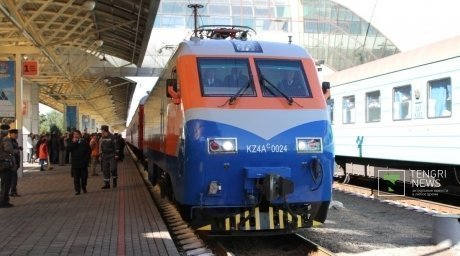
China and the Silk Road: Marching Westward
Publication: Eurasia Daily Monitor Volume: 11 Issue: 40
By:

On November 29, 2013, an international cargo train Chang’an (“Lasting Peace”) departed from Xi’an, the capital city of Shaanxi province in central China, and traveled westward toward Central Asia. On December 9, after a journey of more than 5,000 kilometers, the 49-car train arrived in the Kazakhstani city of Jem (in Aktobe region in the country’s west). The Chang’an was loaded with drilling rig equipment for “CNPC-Aktobe,” (China National Petroleum Corporation) the first Sino-Kazakh energy enterprise to develop the Zhanazhol oil field. The train then further proceeded along the route Kazakhstan-Uzbekistan-Kyrgyzstan-Turkmenistan, making stops at nine stations in these countries, including such cities as Pavlodar, Meteo, Kostanay, Shymkent, Tashkent, Sergeli, Alamedin, Chukursai and Farap. This train route is now one of the most convenient ways for freight to move between China and all the countries of Central Asia. Notably, the journey time of 6–10 days along this new east-west corridor is 20 days fewer compared with road travel, reducing transportation costs by 30 percent (https://www.globalpost.com/dispatch/news/xinhua-news-agency/131128/xian-almaty-cargo-train-begins-operation).
Another “Chang’an” train, this one traveling along the 3,860-kilometer Xi’an-Baoji-Urumqi-Alashankou-Almaty route, had departed a day earlier from central China and arrived in the Kazakhstani city of Almaty within six days, on December 4, pulling 90 cars of mechanical components, barite powder, industrial salts, glass tubes and other goods. These two east-west rail corridors, which bypass Russia, connect China with major destinations within Central Asia, western Asia and Europe, strategically traversing through regions where natural resources are being extracted with Chinese investment. However, plans exist to open two more railway routes that may involve Russia, as well: from Xi’an to Rotterdam and from Xi’an to Moscow.
According to China’s Ministry of Railways, many Chinese and foreign companies have shown a great deal of interest in the newly launched east-west Chang’an train routes (https://russian.news.cn/economic/2013-12/30/c_133007717.htm). Among them is the Japanese carmaker Toyota, which currently ships automobiles manufactured in Japan to Kazakhstan via a sea route that takes 70 days. The Chinese railway corridor could reduce this delivery time to just 15 days (https://www.inform.kz/rus/article/2608791). Meanwhile, for the Chinese Shaanxi province, this east-west rail route is essential as it provides a significantly shorter, and thus cheaper, way for factories in central China to export petroleum equipment and heavy trucks—exports worth $98 million annually. Other regions of China as well as countries in East and South Asia will likely be interested in utilizing these routes as well in order reach markets in Central Asian and Europe. Moreover, these rail links, in turn, open up trade prospects for the Central Asian countries themselves to transport their natural resources in the opposite direction.
Although over the last few years a variety of efforts focused on regional integration (the United States proposed its “New Silk Road Initiative” in 2011; Russia has promoted Eurasian integration by championing economic-political projects such as the Eurasian Economic Union), it is China’s Silk Road Economic Belt that is likely to be the most pragmatic vision for the Eurasian space, and one most closely linked to the ancient version of the Silk Road. Beijing’s proposal was first announced by Chinese leader Xi Jinping in the fall of 2013, and by the end of the year his words crystallized into tangible infrastructure projects. “Silk Road Economic Belt” agreements were signed with 24 cities from eight countries along the Silk Road in November 2013 alone (www.arabnews.com/news/518966).
The Chinese project does not focus so much on ideology or geopolitics, as compared with Moscow’s Eurasian Union, but offers economic benefits for its regional partners. Moreover, China exhibits a real willingness to invest significant funds in these related economic projects in Central Asia, in contrast with the US’s Silk Road vision. In 2011, the US ambassador to Afghanistan, Ryan Crocker, said Washington was ready to invest $100 million in the restoration of the Great Silk Road—but this sum is not even comparable to the $1 billion that Kazakhstan alone spent in 2013 to build a 293-km section of railway from the Almaty region to Khorgos on the Chinese border (https://railways.kz/ru/node/4908). Also, while the US has focused its efforts specifically on including Afghanistan within its Silk Road vision for Central Asia, China has instead concentrated on the economic value of co-opting the Gulf countries into its Silk Road Belt projects. To date, only Uzbekistan has built a direct rail link with Afghanistan—Khayraton-Mazar, constructed in 2011—which bypasses both Russia and Iran (https://www.uznews.net/news_print.php?nid=18207&lng=ru).
Russia, meanwhile, has made some modifications to its Eurasian integration model, as it realizes that it needs to embrace the Asian region more broadly. It offered to recreate the Great Silk Road as a unified transport network called “Silk Road Express” by linking its Trans-Siberian railway to link with the railways of South Korea, North Korea, China and then Europe (https://www.businesskorea.co.kr/article/2315/chinese-interest-%E2%80%9Csilk-road-express%E2%80%9D-dream-involving-n-korea-urged-unsuccessful-without). But the Soviet-built infrastructure presents a problem for Chinese engineers: there is a difference in the track gauge between Chinese railways (1,435 millimeters) and the Soviet standard (1,520 millimeters). This rail gauge mismatch between the Chinese and post-Soviet infrastructure networks creates additional costs and wasted time, so for China, building all-new infrastructure independent of Russia is a way to avoid these complications.
Central Asian countries all seem to support the Chinese initiative. Kazakhstan and Kyrgyzstan, which both share a border with China, may serve as important transit hubs in Central Asia. On January 7, 2014, the Chinese People’s Daily reported that in 2013 “the bilateral trade between China and the five Central Asian countries [exceeded] $46 billion, which sets a new historical record” (https://rus.ozodi.org/content/china-economic-strategy-challenges-usa-russia-/25226307.html). Trade with Kazakhstan made up more than a half of this volume—$24 billion—and is projected to reach $40 billion in 2015.
For China, the Silk Road Economic Belt also has important domestic implications: Beijing sees it as a way to smooth out the regional imbalances inside the country as well as keep the situation in Xinjiang, with its restive Uighur population, under better economic control. Currently, China does not see any major geopolitical contradictions between pursuing its own plans for Central Asia and the contrasting integrationist plans put forth by the United States or Russia. Rather, Beijing confidently continues to invest in what it calls “marching Westward”—for its own economic sake.




